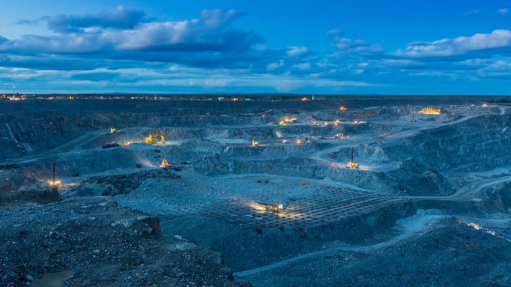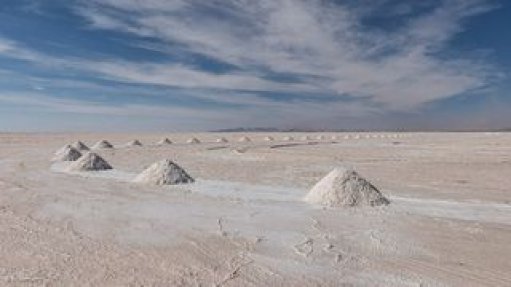Two-part modernisation of Amandelbult platinum mine under way

Anglo American Platinum CEO Natascha Viljoen interviewed by Mining Weekly's Martin Creamer. Video: Darlene Creamer.
JOHANNESBURG (miningweekly.com) – Two-part modernisation is under way at the Amandelbult underground platinum group metals (PGMs) mine of Anglo American Platinum (Amplats), one where conventional mine design remains intact but is renedered safer and more efficient, and the other involving mechanisation and the deployment of low-profile equipment in a new area of the Limpopo mine.
“Amandelbult is a conventional underground platinum mine and if we consider both safety and efficiency of conventional mining, it is important for us to consider alternative ways of making conventional mining safer and more efficient,” Amplats CEO Natascha Viljoen told Mining Weekly in an online interview. (Also watch attached Creamer Media video.)
At the existing operation, tools and equipment that are safer and economically friendlier will improve efficiency, with the mine design remaining unchanged, and then, in newer areas of the mine, mechanisation is envisaged.
“To convert a conventional mine into a mechanised mine is very often very difficult, if not impossible. So, that’s why we’re targeting new areas in the mine, and the first area that we are targeting is 15 East Dropdown, and we’ve been doing our development into this mining area. The mine design is done and we will be deploying low-profile equipment for stoping," said Viljoen. The stoping widths are of the order of 900 mm to 1.2 m and stoping is due to start there in the second half of this year.
“It’s not the height of the stope that is, in this specific case, the challenge for us. It’s more the steeper dip of the orebody,” said Viljoen, adding that although the low-profile machines had been put through their paces, that had taken place in the less steep environment of Amplats’ Twickenham mine.
On mechanisation and the need to create jobs, Viljoen spoke of the ability of mines that remain economic through the cycle being able to maintain jobs both inside and outside of the mine gate.
Amplats has a strategy of supporting the development of five job opportunities outside the mine gate for every one job inside the mine gate.
“So, when we talk about modernisation and mechanisation, it’s to make sure that we remain relevant and remain economic through the cycle, without walking away from our social responsibility to the country,” Viljoen added.
MODERNISING MOGALAKWENA MINE
Different mining methods are also being explored at Amplats’ opencast Mogalakwena mine, in Limpopo.
“Suffice to say at this stage, Mogalakwena will be modernised and mechanised. We're very early in that process and we’re fast-tracking our drilling programme to understand the orebody, and then we’ll match the mining method. But the intention would be for Mogalakwena to be very modern and very mechanised,” she reiterated.
Questioned by Mining Weekly on Mogalakwena going underground, Viljoen said that even though openpit definitely had its benefits, the environmental and social impacts of surface exposure had to be taken into account when weighing up those benefits.
“There’s a huge excitement about the future of Mogalakwena. I think equally, though, when prices are high, we’ve seen in 2008, our discipline around appropriate capital allocation is important. If we consider that Mogalakwena has got a 50-year-plus life and what we are setting out to do could set the direction of this asset for the next ten to 20 years, taking a year or two longer, not being enticed by good prices but making the fundamental correct decisions to ensure that this asset remains at the bottom end of the cost curve throughout the cycles, is what we’re busy with.
“I often ask myself should we be moving faster, should we be moving slower, we all get very excited about the opportunities in the near term, which are real, but if you have a fundamental belief in the industry and in the future of our product, which we do, then taking it slightly slower and making the right decisions would be the important thing. The other thing to that point is that we often think that we do have this beautiful asset called Mogalakwena but we’ve got three other equally beautiful assets which have very specific roles to play in our portfolio, and we are continuously considering how they play their role in the future of our portfolio,” Viljoen said.
The three assets referred to, and for which future opportunities are being considered, are Mototolo, in Limpopo, Unki, in Zimbabwe, and Modikwa, a joint venture (JV) with African Rainbow Minerals. Kroondal, the JV with Sibanye-Stillwater, is being mined to its natural end.
MAINTENANCE STRATEGY
On the maintenance front, Viljoen spoke of Amplats following very disciplined and scientific methods in understanding the current state of its assets and using technology to do that. This involved not only the monitoring of infrastructure but also the continuous monitoring of equipment and the consequent alignment of the maintenance strategy to risk.
“Unless you’ve got a very good view of the current state of your assets, it’s very difficult to make those risk-based decisions. We often think about stay-in-business capital allocation only around developments and pushbacks in terms of mining assets - we forget that there’s other infrastructure that we need to look at and we also forget that it’s about how we operate these assets.
“Being prioritised from a maintenance point of view is structural integrity. Very often if you look at your equipment you can go through a replacement cycle, whereas structural integrity, whether it’s steel or concrete and then other of your infrastructure like electrical substations, that kind of backbone infrastructure that we very often forget and that does age, that is our focus at the moment,” Viljoen said.
Comments
Press Office
Announcements
What's On
Subscribe to improve your user experience...
Option 1 (equivalent of R125 a month):
Receive a weekly copy of Creamer Media's Engineering News & Mining Weekly magazine
(print copy for those in South Africa and e-magazine for those outside of South Africa)
Receive daily email newsletters
Access to full search results
Access archive of magazine back copies
Access to Projects in Progress
Access to ONE Research Report of your choice in PDF format
Option 2 (equivalent of R375 a month):
All benefits from Option 1
PLUS
Access to Creamer Media's Research Channel Africa for ALL Research Reports, in PDF format, on various industrial and mining sectors
including Electricity; Water; Energy Transition; Hydrogen; Roads, Rail and Ports; Coal; Gold; Platinum; Battery Metals; etc.
Already a subscriber?
Forgotten your password?
Receive weekly copy of Creamer Media's Engineering News & Mining Weekly magazine (print copy for those in South Africa and e-magazine for those outside of South Africa)
➕
Recieve daily email newsletters
➕
Access to full search results
➕
Access archive of magazine back copies
➕
Access to Projects in Progress
➕
Access to ONE Research Report of your choice in PDF format
RESEARCH CHANNEL AFRICA
R4500 (equivalent of R375 a month)
SUBSCRIBEAll benefits from Option 1
➕
Access to Creamer Media's Research Channel Africa for ALL Research Reports on various industrial and mining sectors, in PDF format, including on:
Electricity
➕
Water
➕
Energy Transition
➕
Hydrogen
➕
Roads, Rail and Ports
➕
Coal
➕
Gold
➕
Platinum
➕
Battery Metals
➕
etc.
Receive all benefits from Option 1 or Option 2 delivered to numerous people at your company
➕
Multiple User names and Passwords for simultaneous log-ins
➕
Intranet integration access to all in your organisation



















